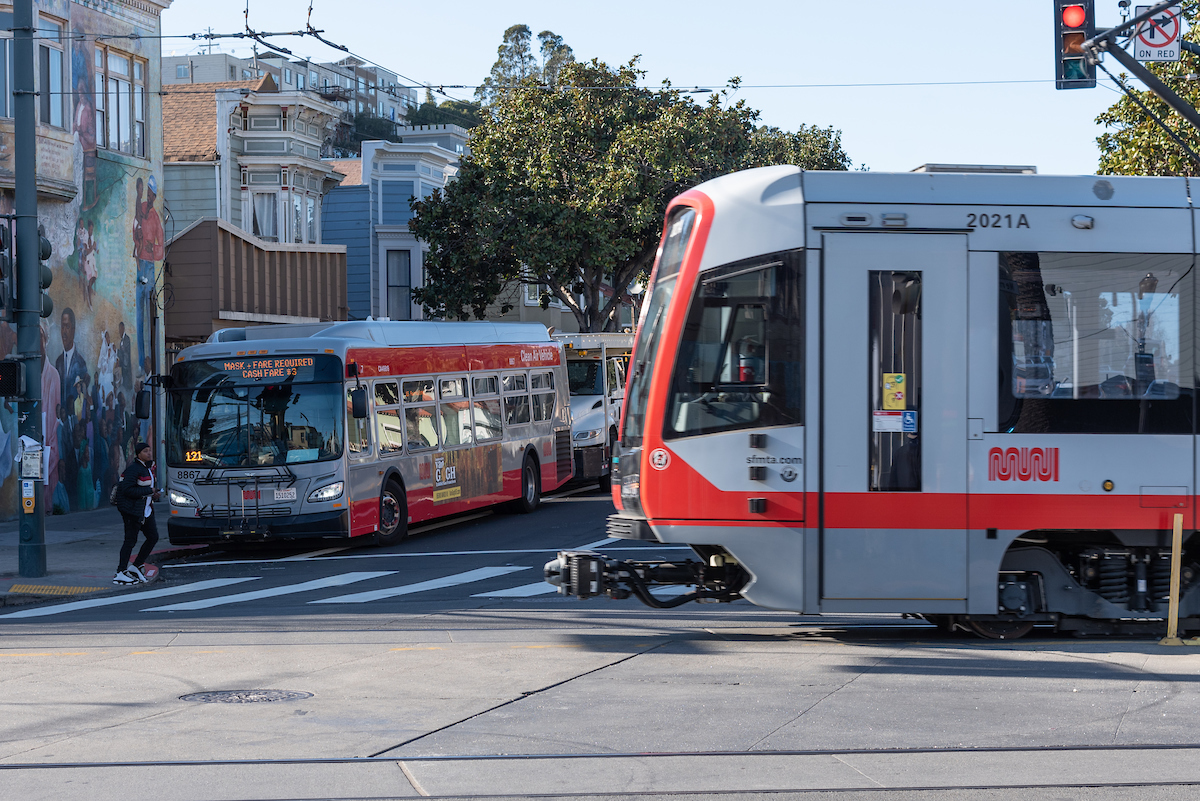
Photo: SFMTA
A new Metropolitan Transportation Commission (MTC) advisory group tasked with evaluating governance reforms met for the first time on January 10 amid pressure to create a cohesive regional transit system that people would use for more trips.
The Network Management Business Case Advisory Group was born from recent MTC policy and planning efforts to address ridership, financial, and other challenges hitting Bay Area transit systems because of the COVID-19 pandemic.
The need to reshape regional transit is not a new idea. A crush of projects, plans, and legislation has been introduced over the years to make trip planning and fare payment a seamless experience for riders. At present, 27 agencies provide local transit services across the region, but no single entity is responsible for coordinating the system as a whole.
With that in mind, the 14-member advisory group brings together transit operators and other individuals representing transit policy, advocacy, and planning. As part of the kick-off meeting, the group elected Denis Mulligan, general manager of the Golden Gate Bridge, Highway and Transportation District, as chair and Alicia John-Baptiste, president and CEO of advocacy organization SPUR, as vice-chair.
The meeting offered a chance to outline the advisory group’s goals and objectives for the nine-month term ending in September.
The group’s creation builds off MTC’s Blue Ribbon Transit Recovery Task Force (BRTRTF) which wrapped up 14 months of work in July. It approved 27 near-term actions to make public transportation a more connected and efficient customer-focused system across the Bay Area.
Those actions form the backbone of the Bay Area Transit Transformation Action Plan, which MTC approved in the fall. MTC hired a team of consultants to perform a network management business case analysis along with that plan. The advisory group is guiding this work.
One of the first steps is to identify key network management issues as the region confronts another pandemic year and a shifting economic environment. During the meeting, advisory group members discussed the need to focus broadly on equity, labor interests, and priorities for low-income and disabled riders. Some members also noted it’s important to factor in ties with other MTC policy objectives like climate, transit fares, and regional rail.
“We need to be bold here,” said Jim Wunderman, advisory group member and president and CEO of the Bay Area Council, during his remarks.

Photo: SFMTA
A key question to address is what form of governance can create better outcomes for riders and the region as a whole? September’s Regional Network Management Structures Evaluation Report, prepared by the consulting team as part of the Action Plan effort, proposed several network management vs. network manager scenarios formed within or outside MTC.
One idea from the report is to keep with the status quo. Regional collaboration occurs through an “ad hoc model” of regional consensus and shared decision-making with MTC, transit operators, and city and county stakeholders. It pointed to recent initiatives like the BRTRTF, MTC’s Fare Integration Task Force, and the Clipper Executive Board as examples of active collaborations that “have achieved notable progress.”
Even so, financial and operational complexities can present barriers to visions of coordinated mobility across the Bay Area. During the meeting, transit advocates expressed concern about a status quo approach and emphasized the need for public investment in transit.
“I really hope this is going to be a different moment in time,” said Ian Griffiths, policy director at Seamless Bay Area, a group campaigning for a unified regional transit network.
The report also suggested creating a new agency — separate from MTC — with independent authority to lead regional network manager activities in the Bay Area. Another option is developing a new organizational unit within MTC to centralize accountability, authority, and organizational resources for regional network management.
As part of its overall analysis, the consulting team and advisory group will consider benefits, costs, funding, and risks associated with the proposed management arrangements. The regional network management structures are a “starting point,” and the public should expect additions, refinements, or variants early in this process, according to January 10 meeting materials.
The timeline presented at the meeting shows the MTC commission “takes action on a preferred network management alternative” by late summer/early fall, based on a recommendation from the consultant team after it completes the evaluation. . The group’s meetings are open to the public, with the next slated for March 7. It will focus on the project workplace and expectations summary, as well as understanding linkages to the Bay Area Regional Rail Partnerships study. View upcoming meeting schedules and agendas to participate in a meeting and provide input.

Photo: MTC

